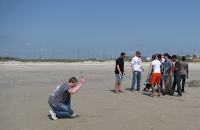By now all are well aware of the well blowout in the gulf at the 'Deepwater Horizon' site. Thus far several attempts have been made to curb the flow of crude into the gulf, but none have worked. One of the first attempts was to use a dome structure to cover the rupture and direct the oil to a waiting barge. This dome quickly filled with gas hydrate and was made much more buoyant by the hydrate (density of hydrate is less than that of water, especially sea water). Attached is a picture of the 4-story dome courtesy telegraph.co.uk. I feel it is important to point out a few things about hydrate the media has either left out or stated incorrectly.
First, what is gas hydrate? The most common buzz word I've seen is 'crystalline gas' or 'solid gas'. These are contradictions. We know there are three basic states of matter: solids, liquids, and gasses. (There are also plasmas, Bose-Einstein condensates, string-net liquids, and so on.) You can see that a 'solid gas' is simply incorrect! Gas hydrates are cages of water molecules with a guest molecule of gas trapped inside. There are different types of cages for different sizes of guest molecules. Though the material can look like ice it is fundamentally different.
Under the ocean there is quite a lot of methane hydrate. We have known about hydrate for some time and it's important for past climate change, possible energy production, and as a potential hazard for sea slopes and drilling operations. Dr. Robert Bea of UC Berkeley has suggested that Halliburton cementing the well only 20 hours before the explosion on the rig is important. When cement is hardening is releases heat. This heat of crystallization could have heated the hydrate up. The hydrate weakened the concrete and as it was melting released its gas, causing a surge of pressure to the rig.
Hydrates have been a problem to the industry before, clogging pipelines and apparatus. Hydrates only form under certain pressure and temperature conditions, so the areas can simply be kept out of P-T ranges where hydrate would be stable. This is easier said than done, and sometimes inhibitors are injected. Chemicals such as methanol decrease the stability of hydrate.
So what is the plan now? Currently an attempt to place a new, capped section of pipe on is underway. The difficulty with any plugging operation is the pressure at which the fluid is shooting out. If this fails a smaller dome has been built in hopes that it will remain warmer and hydrate will not be stable. There are also measures in place to inject hydrate inhibitors, though this could have unknown environmental impacts. Currently oil continues to gush out at about 210, 000 gallons/day. Below is an image from NOAA (May 11) showing the spread of oil then some links to follow. Numerical modeling of the spread has done surprisingly well as has put rapid mathematical modeling in the spotlight also.

Afterthought:
I received a question about why the flow rate estimates were so widely varied. In the video of the flow you can see both oil and gas phases coming out of the pipe. If it were just one phase, knowing the scale and frame rate of the pipe would be sufficient to get an accurate estimate. It could be that as oil is releasing pressure more hydrate is dissociating and causing the bursts of mixed gas making the flow hard to figure.
LINKS:
Video of Oil Leak
NOAA Page on the Accident (Updated Daily)
LA Times Article on Dr.Bea's Idea



























